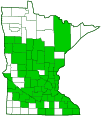six-spotted tiger beetle
(Cicindela sexguttata)
Conservation • Description • Habitat • Ecology • Distribution • Taxonomy
Conservation Status |
|
|||||||
| IUCN Red List | not listed |
|||||||
| NatureServe | N5 - Secure S5 - Secure |
|||||||
| Minnesota | not listed |
|||||||
Description |
||
Six-spotted tiger beetle is a small predaceous, tiger beetle. It may be the most common species of tiger beetle in eastern North America. Adults are ⅜″ to 9 ⁄16″ long. The hardened wing covers (elytra) are shiny, iridescent, metallic green to bluish-green, occasionally greenish-blue or all blue. They are somewhat wider beyond the middle. There are usually three spots on each elytra: two lateral spots near the margin and a dash near the rear. There is usually an additional small spot on each elytra between the lateral spots in the middle of the elytra. There is rarely an additional small spot near the margin between the upper lateral spot and the front (humeral) angle. Occasionally, some or all white spots will be absent. The plate covering the thorax (pronotum) is narrower than and the same color as the elytra. The head at the eyes is as wide or wider than the pronotum. It is the same color as the elytra and pronotum. The eyes are large and bulging. The antennae are thread-like, have 11 segments, and are inserted above the base of the mandibles. The mouthpart between the mandibles (labrum), often likened to an upper lip, is small and has a single tooth. The legs are long and slender. All legs have five end segments (tarsi). |
||
Size |
||
Total length: ⅜″ to 9 ⁄16″ |
||
Sign |
||
Adults and larval burrows are very often seen on paths in the woods. Six-spotted tiger beetle can be thought of as a woodland path species. |
||
Similar Species |
||
| Laurentian tiger beetle (Cicindela denikei) is slightly larger. The wings have no white spots. Its range, restricted to the boreal forest in the five northeasternmost counties, does not overlap. | ||
Habitat |
||
Open, sunny areas in deciduous and mixed woodlands; forest edges and openings; trails, dirt paths, fallen logs. |
||
Ecology |
||
Season |
||
April to early July |
||
Behavior |
||
The larva sits inside its burrow and waits for any insect unlucky enough to pass by. When it detects prey it pops out, seizes the insect, drags it to the bottom of the tunnel, and eats it there. |
||
Life Cycle |
||
After mating the female digs a hole in the soil, deposits a single egg, then covers the hole. The egg hatches and the emergent larva burrows further into the soil creating a tunnel. It overwinters in the burrow, developing for about a year before pupating. This beetle lives for almost five years. Adults overwinter in pupal burrows. Unlike most tiger beetles, six-spotted tiger beetle is seen mostly in the spring, rarely in the fall. |
||
Larva Food |
||
Any insect the larva can get into its hole |
||
Adult Food |
||
Small insects and spiders |
||
Distribution |
||||
|
Sources |
|||
| 6/13/2022 | ||||
Occurrence |
||||
Very common |
||||
Taxonomy |
|||
Order |
Coleoptera (Beetles) | ||
Suborder |
Adephaga (Ground and Water Beetles) | ||
Superfamily |
Caraboidea (Ground Beetles and Allies) | ||
Family |
Carabidae (Ground Beetles) | ||
Subfamily |
Cicindelinae (tiger beetles) | ||
Tribe |
Cicindelini (flashy tiger beetles) | ||
| Subtribe | Cicindelina | ||
Genus |
Cicindela (common tiger beetles) | ||
Subgenus |
Cicindela | ||
Synonyms |
|||
Cicindela sexguttata sexguttata |
|||
Common Names |
|||
six-spotted tiger beetle |
|||
Glossary
Elytra
The hardened or leathery forewings of beetles used to protect the fragile hindwings, which are used for flying. Singular: elytron.
Pronotum
The exoskeletal plate on the upper side of the first segment of the thorax of an insect.
Tarsus
The last two to five sections of an insect’s leg, attached to the tibia; the foot. Plural: tarsi.
Visitor Photos |
|||||
Share your photo of this insect. |
|||||
| This button not working for you? Simply email us at info@MinnesotaSeasons.com. Attach one or more photos and, if you like, a caption. |
|||||
Greg Watson |
|||||
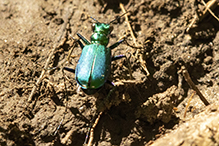 |
|||||
Alfredo Colon |
|||||
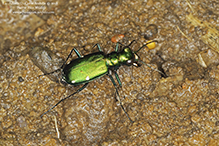 |
|||||
Dan W. Andree |
|||||
Six-spotted Tiger Beetle... I wasn’t sure if this was a six-spotted tiger beetle until a specialist in the area (Val Cervenka) confirmed it was. I was informed the spots can vary from zero to eight. It was a small beetle maybe a half inch or just over that. It was quite an interesting looking little creature from the front face view. Came across it recently on a grassy part of a hiking trail near Twin Valley, Mn. It just kind of sat there briefly while I photographed it then took off. |
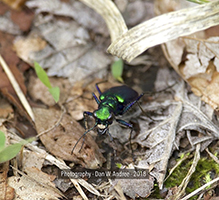 |
||||
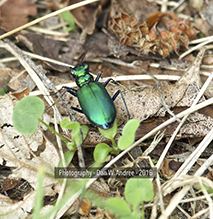 |
|||||
MinnesotaSeasons.com Photos |
|||||
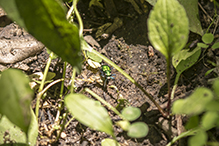 |
|||||

Visitor Videos |
|||
Share your video of this insect. |
|||
| This button not working for you? Simply email us at info@MinnesotaSeasons.com. Attach a video, a YouTube link, or a cloud storage link. |
|||
Other Videos |
|||
| Cicindela Sexguttata (Six Spotted Tiger Beetle) Torn80cj |
|||
About
Published on Jun 24, 2013 These beetles are actually beneficial since they mainly eat bugs that are pests. |
|||
| Six-spotted Tiger Beetle (Carabidae: Cicindela sexguttata) Nearly Spotless Carl Barrentine |
|||
About
Published on Jun 16, 2010 Photographed near Fisher, Minnesota (16 June 2010). |
|||
| Six-spotted Green Tiger Beetle Cicindela sexguttata victor abbley |
|||
About
Published on May 26, 2011 Flower Mound Texas, Six-spotted Green Tiger Beetle Cicindela sexguttata. A good close up of a brilliantly colored tiger beetle moving around franticly as this doesent end well. This poor guy dies in the river after tripping in a spider web |
|||
| Tiger Beetle Bites my Finger! Nature Now! Chris Egnoto - The Naturalist's Path |
|||
About
Published on Jun 24, 2017 Here is a video on the amazing Tiger Beetle. These beetles are ferocious as far as their size and predatory behavior is concerned. Brilliant green and huge white jaws make this predator a beautiful and beneficial insect to find in your garden. Later on in the video, you can witness my being bitten on my finger by those massive jaws! |
|||


Last Updated:
